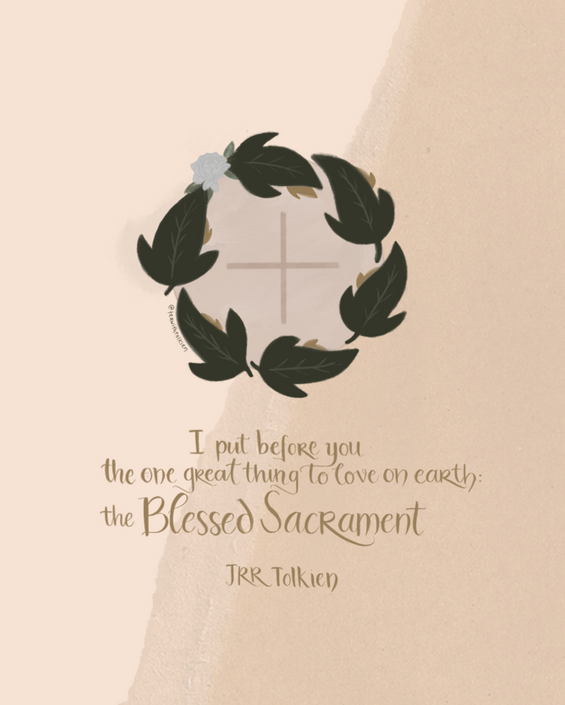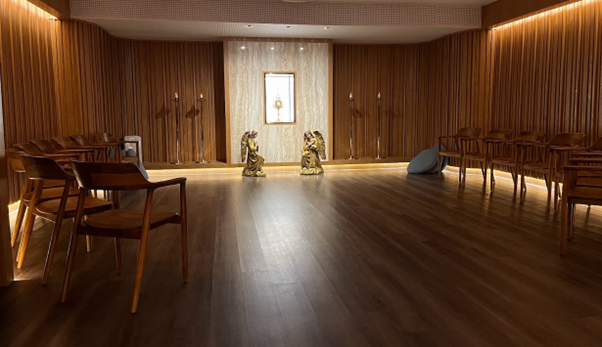BREAD FOR OUR JOURNEY
The Solemn Feast of the Body (and Blood) of Christ, or Corpus Christi in Latin, celebrates Jesus Christ truly present in the Holy Eucharist Body, Blood, Soul, and Divinity. It actually falls on the Thursday after Trinity Sunday, and being a Thursday, our minds should draw a parallel to the feast of Maundy Thursday which commemorates the institution of the Eucharist. However, Maundy Thursday is marked by the shadow of the Cross, and while our Christian minds and hearts remember Jesus giving us the great mandate to “Do this in memory of me” at the Evening Mass of the Last Supper, we are also celebrating the Institution of the Priesthood, Jesus’s washing His disciples feet, the vigil in the Garden of Gethsemane, and anticipating the Passion, Death, and Resurrection of Christ. In celebrating Corpus Christi after Trinity Sunday, our focus is once again drawn back to the Eucharist without the other Paschal Triduum themes present.
Origins of the Feast
This feast was declared throughout the Universal Catholic Church by Pope Urban IV on 11 Aug 1264 in his Papal Bull Transiturus de mundo ad Patrem. In addition to his contributions to the Papal Bull, St Thomas Aquinas was also given the task to draw up the liturgy for Corpus Christi. It is from this commission where we get the four beautiful and much beloved Catholic Eucharistic hymns,
1. Pange Lingua Glorisi (the last two stanzas being Tantum Ergo Sacramentum)
2. Verbum Supernum (the last two stanzas being O Salutaris Hostia)
3. Sacris Solemniis (stanza 6 is the Panis Angelicus), and
4. Lauda Sion Salvatorem (the Sequence for Corpus Christi).
The Pange Lingua Gloriosi (“Sing my Tongue, the Saviour’s Glory”), with the last two stanzas Tantum Ergo Sacramentum (“Down in Adoration Falling”) still used today in our Benedictions at Eucharistic Adorations.
Legend has it that Pope Urban IV commissioned both St Thomas Aquinas and St Bonaventure to compose both the Mass and Office[i] for this great feast. When the time came to present their manuscripts to the Holy Father, St Thomas went first. His reading moved both the Pope and St Bonaventure to tears, and St Bonaventure tore up his manuscripts, saying, “Holy Father, listening to Fr. Thomas, it seemed as if I heard the Holy Spirit speak, for only the Holy Spirit can inspire such beautiful thoughts. It is out of place for me to compare my poor essay with such a perfect masterpiece; and this is all that remains of it!”
Our Origin and Destination
The Eucharist is the “Source and Summit of the Christian Life”[ii], from where we draw our daily strength from, and to where we direct our minds, hearts, and energies towards. Many Saints have spoken lovingly of the Eucharist. St. Alphonsus Maria de Liguori, the founder of the Redemptorists, wrote a small book “Visits to the Blessed Sacrament” in which he gives us some simple meditations to help us enter deeper into the presence of the Blessed Sacrament and to fall in love with Jesus. It was said that these simple but profound meditations moved the heart of St Alphonsus’ own father!
St Thérèse of the Child Jesus and the Holy Face[iii] lovingly wrote, “O Jesus! on this day, you have fulfilled all my desires. From now on, near the Eucharist, I shall be able To sacrifice myself in silence, to wait for Heaven in peace. Keeping myself open to the rays of the Divine Host, In this furnace of love, I shall be consumed, And like a seraphim, Lord, I shall love You.”[iv] St Thérèse also said of Eucharistic Adorations, “Heaven for me is hidden in a little host where Jesus, my spouse, is veiled for love. I go to that divine furnace to draw out life, and there my sweet saviour listens to me night and day.”[v]
The Carmelite mystic, St Teresa of Jesus[vi], gives us good advice when we receive Holy Communion, “But after having received the Lord, since you have the Person Himself present, strive to close the eyes of the body and open those of the soul and look into your own heart. ... you should acquire the habit of doing this every time you receive Communion. ... Though He comes disguised, the disguise, as I have said, does not prevent Him from being recognized in many ways, in conformity with the desire we have to see Him. And you can desire to see Him so much that He will reveal Himself to you entirely.” [vii]
The Eucharist in Popular Culture
"Eat little at a time, and only at need. For these things are given to serve you when all else fails… One will keep a traveller on his feet for a day of long labour." [viii]
The Eucharist has also figured in popular culture. In J.R.R. Tolkien’s [ix] Lord of the Rings, Lembas bread was food for the journey to sustain Frodo and Sam through their various trials and tribulations as the journeyed to Mount Doom. During moments of great inner darkness, anguish, and despair, Lembas provided that supernatural strength that fortified their will in their journey. It is telling that Gollum is physically not able to eat Lembas bread as he was corrupted by evil and refused to eat it. In the journey, as Frodo became more and more corrupted by the influence of the ring, he began to refuse to eat the Lembas bread. But Sam in his wisdom and friendship continued to feed Frodo the Lembas bread and this sustained and strengthened Frodo until the completion of their journey. Tolkien was a deeply Catholic man and wove the Eucharist into this much cherished trilogy. Tolken himself drew strength from the Eucharist, the “one great thing to love on earth: the Blessed Sacrament.” He used to go to daily Mass for strength, and once wrote to his son Michael. "The only cure for sagging or fainting faith is Communion. Though always itself, perfect and complete and inviolate, the Blessed Sacrament does not operate completely and once for all in any of us. Like the act of Faith it must be continuous and grow by exercise. Seven times a week is more nourishing than seven times at intervals.” [x]
What it means for us
“Take, and eat. This is my body.” God gives of Himself to strengthen and sustain us in our daily life. What appears to be a small wafer of bread to our senses has been transformed through the actions of the priest during Mass to become bread for our life’s journey. It not only nourishes our bodies, but it also strengthens our will and resolve to become more like Christ. Our bodies biologically break down all that we eat and uses that to build up, repair, and restore our own bodies, and in truth we become more and more like what we eat.
I invite you to spend some time in adoration of the Blessed Sacrament. While the world may tell us that we are “wasting time”, remember that time itself is a gift from God to us. Let us use some of that gift he has given us to love Him in return. Let’s come away to have regular heart-to-heart conversation with one who we truly know loves us.
In Singapore, and wherever else in the world where Thursday is not a holy day of obligation, the feast is transferred to the following Sunday (i.e. Sunday after Trinity Sunday) to allow greater participation of the faithful. This great Solemnity is also marked by grand celebrations that strive to help us to put Jesus, True Presence in the Eucharist at the centre of our worship. Some parishes may organise Eucharistic Processions, public Adorations and Holy Hours to help us to spend some time with the Blessed Sacrament.
Corpus Christi falls on 2 June this year. Our Parish is celebrating Corpus Christi with Eucharistic Adoration from 1:45 pm to 4.45 pm, led by various groups in our parish. We invite you to come with your family, to spend some time in worship and prayer. Even better, stop by our beautiful Adoration Room once in a while to spend time to recollect our thoughts and simply to sit with a Friend.
I leave you with the beloved Eucharistic Hymn, O Salutaris Hostia.
_____________________________________________________________________
References:
[i] What we know today as the celebration of the Divine Office, the Liturgy of the Hours.
[ii] Catechism of the Catholic Church, 1324-1327
[iii] The religious name of St. Thérèse of Lisieux, born Marie Françoise-Thérèse Martin on 2 January 1873 in Alençon, France.
[iv] St. Thérèse of Lisieux, Canticle of a Soul Having Found the Place of Its Rest!, Stanza 3
[v] St. Thérèse of Lisieux, Heaven for Me, Stanza 3
[vi] The religious name of St Teresa of Avila, born Teresa Ali Fatim Corella Sanchez de Capeda y Ahumada on 28 March 1515 in Avila, Spain.
[vii] St. Teresa of Avila, Way of Perfection, ch.34, no.12.
[viii] J.R.R. Tolkien, The Fellowship of the Ring
[ix] John Ronald Reuel Tolkien CBE FRSL, born 3 January 1892. A writer and philologist known for writing books on Middle-Earth, the most famous of which are the Lord of the Rings Trilogy and the Hobbit.
[x] J.R.R. Tolkien, The Letters of J.R.R. Tolkien, Letter 250 to his son Michael
Article by Daniel Tham, HFC Blog Contributor




